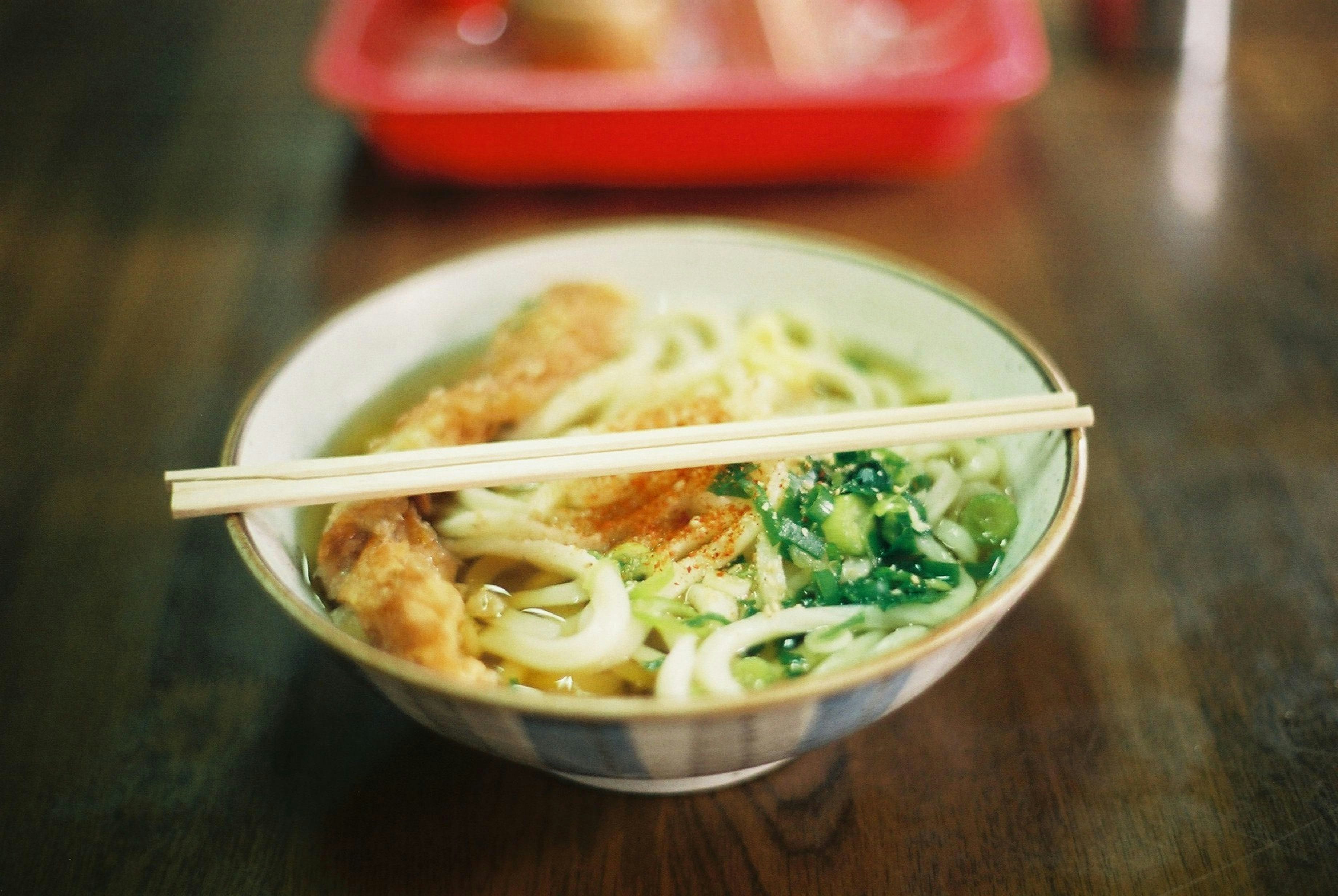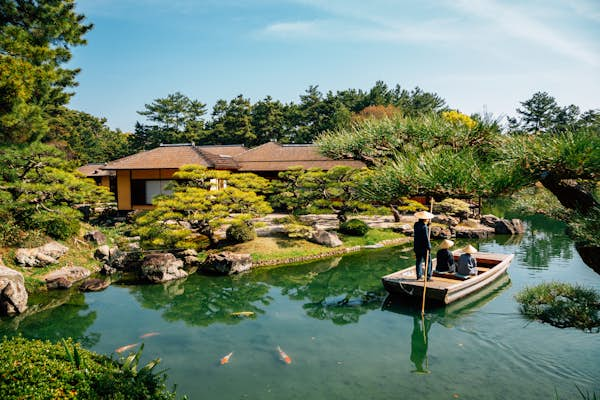Kagawa, on the island region of Shikoku, may be Japan’s smallest prefecture, but that means its attractions are within quicker reach. Kagawa’s mainland offers vistas of its islands, and you only need to jump on a quick ferry into the glorious Seto Inland Sea to visit them.
Once largely unknown locales quietly succumbing to depopulation, a number of Kagawa’s islands have been transformed into innovative “art islands” featuring indoor and outdoor contemporary works by some of Japan’s most renowned artists and designers.
Advertisement
On Kagawa’s mainland, find ancient battlegrounds, revered pilgrimage sites and fine feudal gardens that maintain modern-day connections to the history and culture of old Sanuki province. Using the lively prefectural capital Takamatsu as a starting point, allow these eight top suggestions to lead you to some of the best of Kagawa.
1. Stroll the garden of feudal lords at Ritsurin-kōen
Japan has no shortage of manicured gardens, but you’ll want to make room in your itinerary for Takamatsu’s magnificent Ritsurin-kōen, awarded the maximum three stars in the Michelin Green Guide for attractions that are “worth a special journey.” Once the stomping grounds of Edo era’s elite, the garden has 75 immaculate hectares featuring six ponds, 13 landscaped hills and over 1000 pine trees, given further scale by the ancient burial grounds of Mt Shiun as its towering backdrop.
Don’t miss the South Pond – the representative image gracing the cover of just about every tourist brochure for the prefecture – where you’ll find the garden’s largest bridge, three islands and Kikugetsu-tei, a teahouse as old as the garden itself. Take in the grandeur of the South Pond from the teahouse’s spectacular tatami viewing area that opens out to the water (undeniably worth the cost of a cup of tea and a sweet that grants you entry). You may also opt to take a leisurely 30-minute wasen boat ride.
Planning tip: Book your boat ride online up to 5pm the day before, or make a beeline for the boat ticket counter inside the garden grounds for same-day tickets (pending availability) from 8:30am.

2. Slurp on Kagawa’s ‘all-day’ noodles
Initiating yourself into local dining culture is as easy as joining one of the fast-moving queues at a Sanuki udon restaurant. Kagawa’s delightful square-shaped al dente version of Japan’s thick, wheat-based noodle is available at around 540 dedicated udon restaurants across the prefecture. Noodle dining starts from breakfast, crescendos at lunch with the famished work crowd, and picks up again in the evening, especially on weekends when it’s a favorite late-night post-drinks meal. Broaden your palate by trying different renditions of the quick and cheap dish, from specialty in-house broths to a range of toppings.
Planning tip: Takamatsu has a good concentration of Sanuki udon restaurants in the shopping arcades and entertainment districts between Katahara-machi and Kawara-machi stations. For a culinary experience you won’t soon forget, stomp on your own noodles to the shaking of tambourines in a high-energy workshop at Nakano Udon School (advance reservation required).

3. Immerse yourself in contemporary art on Naoshima
A principal location of the “art islands” of the Seto Inland Sea, Naoshima (25-50 minutes by ferry from Takamatsu) is home to “that yellow pumpkin,” an iconic outdoor sculpture of a polka-dotted pumpkin by artist Yayoi Kusama that has come to be emblematic of the region’s art movement.
Advertisement
Part of Benesse Art Site Naoshima, island-wide museums, galleries and art installations attract visitors keen to experience contemporary design in ways that reimagine the interplay between art and its environment. Pumpkin aside, don’t miss Chichū Art Museum, Benesse House Museum and Naoshima New Museum of Art (opening May 31, 2025), all designed by acclaimed Japanese architect Tadao Andō.
Although Naoshima can be accessed year-round, an exciting time to visit is during Setouchi Triennale – a large contemporary art festival held every three years, featuring Naoshima and 11 other Inland Sea art islands – when even more works are exhibited. (The festival will next be held in 2025 and 2028.)
Planning tip: Many venues offer a discount for advanced online ticket purchase. Avoid Mondays when the island’s museums are closed.
4. Explore Japan’s Mediterraneanesque olive island
Credited as the birthplace of olives in Japan, Shōdoshima’s foray into olive cultivation began as an enterprising way to conserve fish in oil for export at the turn of the 20th century. Kagawa was one of three prefectures where olive production was trialed, but it was only on the temperate island of Shōdoshima off the coast of Takamatsu where the trees managed to survive.
Over 100 years later, the island still accounts for more than 90% of the country’s total shipping volume of olives. You can try just about anything olive-derived here, including noodles, sake, “olive-fed” beef and fish, and oil-infused hair and skincare.
Visit ground zero of the island’s olive success at Shōdoshima Olive Park to walk among the olive groves, view historical exhibits, stock up on olive treats and, interestingly, join the throngs of visitors jumping on broomsticks in front of the Greek Windmill. The unusual photo opportunity re-enacts a scene from the 1989 Studio Ghibli animation Kiki’s Delivery Service, in which the park is featured.
5. Walk in the footsteps of warriors on Yashima
Back on Kagawa’s mainland, the tabletop mountain of Yashima, meaning “roof island,” affords some of the best views in the prefecture within just 10km of downtown Takamatsu. Famously the site of the Battle of Yashima, it was a key location in the great Genpei War between the Genji and Heike clans in the late 12th century, a decade-long dispute that ultimately shaped Shikoku.
The flat mountaintop loop walk takes visitors to key battle sites, including Blood Pond – where the victorious Genji washed the blood from their swords – and the 8th-century temple and Important Cultural Property Yashima-ji, with its Treasure House exhibiting battle-related artifacts.
Planning tip: Time your arrival on the Takamatsu-facing precipice for dusk, where you can catch a spectacular sunset over the city and Inland Sea from Shishi-no-Reigan Observatory. Participate in a practice called kawarake-nage that’s said to bring good luck: buy a clay disc and throw it off the mountainside, symbolizing the Genji warriors throwing their headpieces in victory.

6. Marvel at one of Japan’s last original castles
A train can get you to the seaside city and old castle town of Marugame in less than half an hour, an easy day trip from Takamatsu. An incredible one-third of Japan’s 12 remaining castles that retain their original keep can be found on Shikoku, and Marugame-jō is the region’s oldest.
Perched on a hillside high above the surrounding streets, the impressive views en route to the small 17th-century castle tower are worthy of the steep 10-minute schlep. As simple (and tiny) as the interior is, history enthusiasts willing to negotiate the two precarious flights of stairs in slippers will likely get a kick out of ticking off one of Japan’s original dozen. Tickets are required only for those wanting to enter the keep.
7. Climb 1000-plus steps to a forest shrine
Dedicated to the deity of seafarers and head of all such shrines in the country, Kotohira-gū (also known as Konpira-san) features a noteworthy approach of 1368 steps up the forested slopes of Mt Zōzu. A hike to the main shrine is 45 minutes, and the inner shrine is 30 minutes more. Set aside at least a half-day to be lured by the route’s numerous Edo-era cultural attractions, including Japan’s oldest surviving kabuki theater, Kanamaru-za, the sacred shrine horses in their stables, and the impressive screen paintings at Omote Shoin in the heart of the mountain’s art precinct. Once you descend, rest your weary feet at the free footbath on Omotesandō.
Detour: Continue the pilgrim theme at nearby Zentsū-ji, the largest of the temples on Shikoku’s 88 Temple Pilgrimage and the birthplace of Kōbō Daishi, founder of the pilgrimage and Shingon sect of Buddhism in Japan.
8. Stand in awe of a 400-year-old sandcastle
Created in just one night in 1633 to welcome a visiting feudal lord, Zenigata Sunae is a 345m-circumference sand sculpture in the shape of an Edo-era coin. Located by Ariake Beach on the Kanonji coastline, this unusual attraction has astonishingly been maintained since its creation. The best views are from the elevated observation points on Mt Kotohiki on the eastern boundary of Kotohiki Park. It’s lit up every night from sunset until 10pm.
Detour: Take to more heights at Takaya Shrine with its breathtaking “torii in the sky” on Mt Inazumi, and at Unpen-ji (dubbed the “temple in the clouds”), the highest temple on the 88 Temple Pilgrimage at 900m elevation. Both sites are within a 20-minute drive of the sand art. The Unpenji Ropeway can whisk you to the temple grounds on Mt Unpenji just over the Kagawa-Tokushima border in a mere seven minutes.

